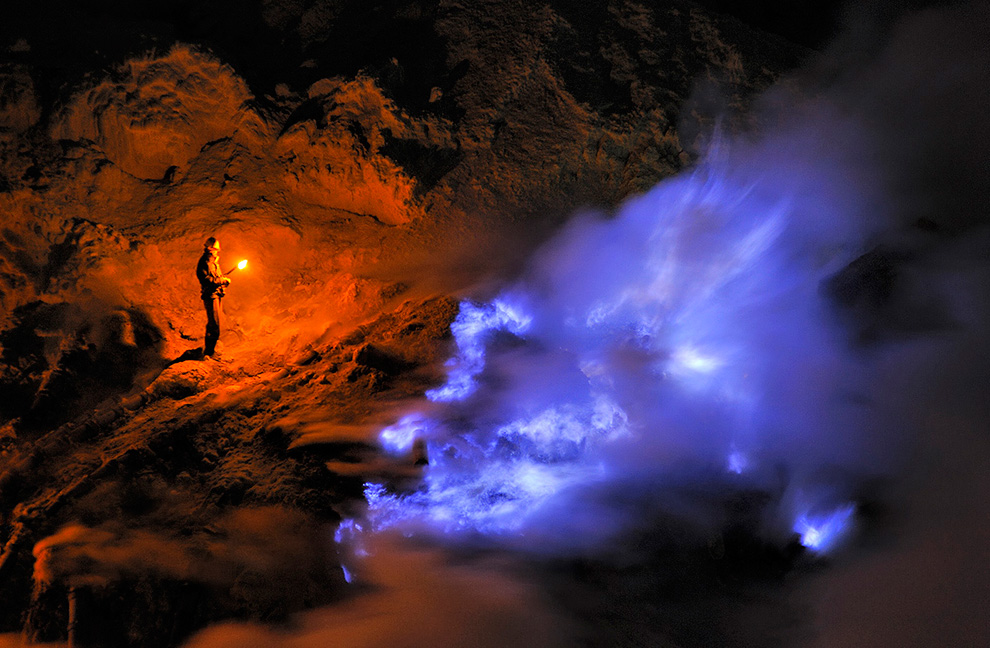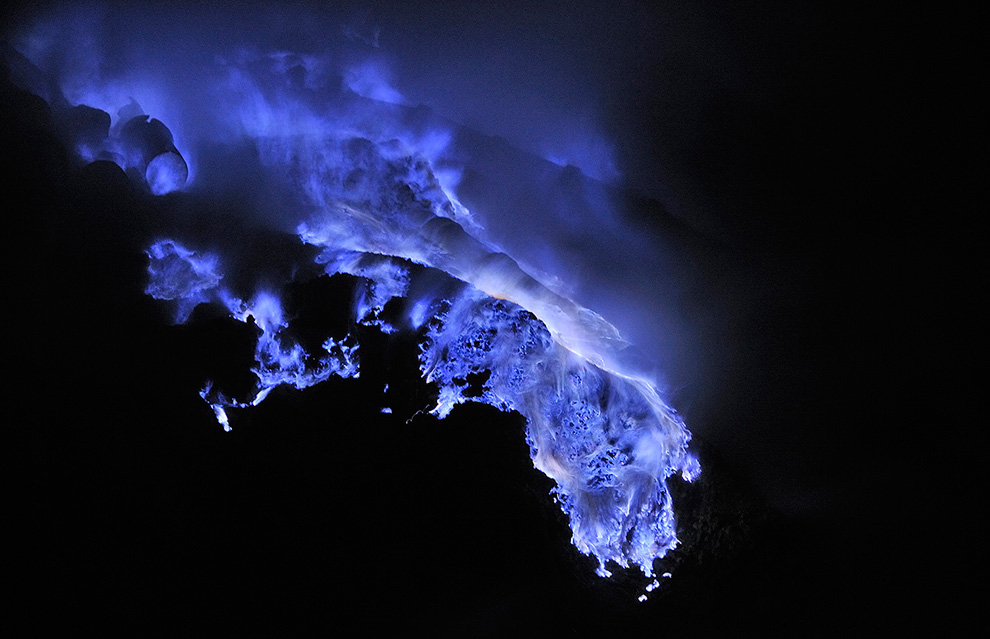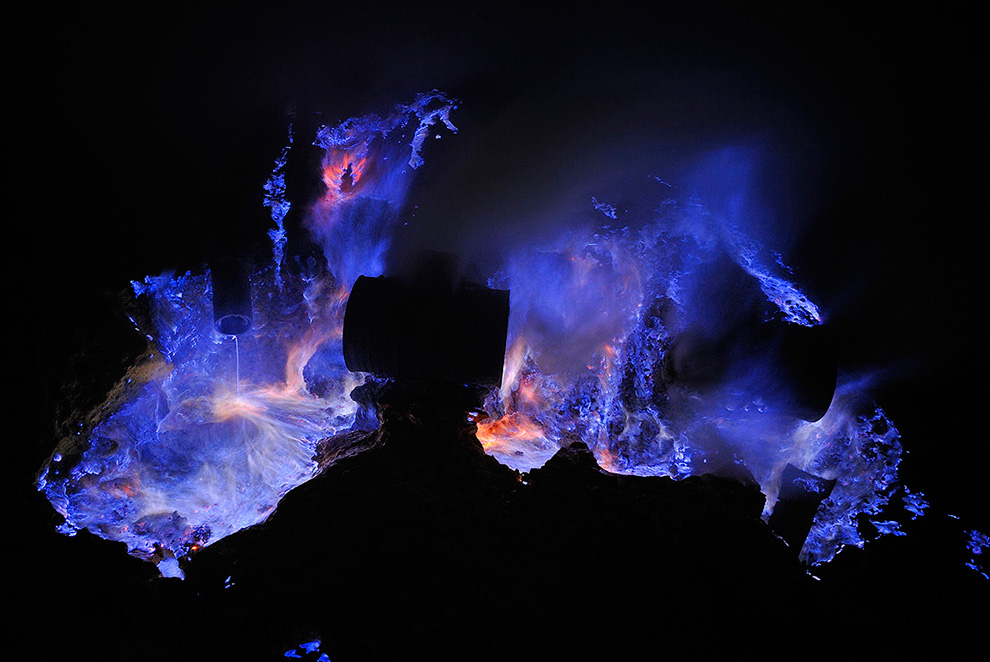Imágenes para ilustrar un artículo sobre mina de azufre en Java
22 September, 2011
En octubre del 2009 titulamos una noticia tomada de elpais.es: La pesadilla del dióxido de azufre en minas de Java. Ahora en el sitio ziza.es invitan a un "Viaje al fondo del cráter": Espectacular recorrido gráfico en la aventura de unos exploradores de volcanes en la isla de Java. El cráter de Idzhen uno de los lugares más increíbles.Ver video
Kawah Ijen, Java, Indonesia
Espectacular recorrido gráfico en la aventura de unos exploradores de volcanes en la isla de Java. El cráter de Idzhen uno de los lugares más increíbles.
Kawah Ijen by night Imagenes de boston.com/bigpicture
Photographer Olivier Grunewald has recently made several trips into the sulfur mine in the crater of the Kawah Ijen volcano in East Java, Indonesia, bringing with him equipment to capture surreal images lit by moonlight, torches, and the blue flames of burning molten sulfur. Covered last year in the Big Picture (in daylight), the miners of the 2,600 meter tall (8,660ft) Kawah Ijen volcano trek up to the crater, then down to the shore of a 200-meter-deep crater lake of sulfuric acid, where they retrieve heavy chunks of pure sulfur to carry back to a weighing station. Mr. Grunewald has been kind enough to share with us the following other-worldly photos of these men as they do their hazardous work under the light of the moon. (30 photos total)
| December 8, 2010 |

A sulfur miner stands inside the crater of the Kawah Ijen volcano at night, holding a torch, looking towards a flow of liquid sulfur which has caught fire and burns with an eerie blue flame. (© Olivier Grunewald)

Descending into the Kawah Ijen caldera, a one-kilometer-wide acidic crater lake lies in the middle. On its shore, the sulfur mining operation. (© Olivier Grunewald) #

Steam and acidic gases emerge from fumaroles among yellowish chunks of sulfur and burning liquid sulfur on Kawah Ijen. (© Olivier Grunewald) #

Flaming molten sulfur flows inside the volcanic crater. Sulfur will melt at just above 100 C (212 F), but the temperatures in the crater do not get high enough for spontaneous combustion – the fires are lit by the miner’s dripping torches. (© Olivier Grunewald) #

A miner chips away hunks of solid sulfur to take with him back to the mine office. (© Olivier Grunewald) #

A sulfur deposit clings to the edge of an old barrel now embedded in sulfur inside Kawah Ijen. (© Olivier Grunewald) #

Miners labor in hellish conditions to retrieve the sulfur – Photographer Olivier Grunewald describes the smell as overwhelming, requiring a gas mask for safety, which few of the miners possess. (© Olivier Grunewald) #

Miners rest near a fire, holding long crowbars they use to pry the sulfur from the crater. (© Olivier Grunewald) #

A formation caused by liquid sulfur flow inside the crater of Kawah Ijen. When molten, sulfur appears nearly blood red, as it cools, it becomes more and more yellow. (© Olivier Grunewald) #

Molten sulfur burns after it drips from stone and ceramic pipes that have condensed the sulfuric gases from the volcano into a liquid, depositing it to cool and harden for later retrieval. (© Olivier Grunewald) #

Lit by torches, miners chop away at the solid sulfur deposits, retrieving chunks they can carry back out. (© Olivier Grunewald) #

A miner works on a block of sulfur, to fit it into the baskets used to carry the mineral out of the volcano. (© Olivier Grunewald) #

Working close to condensation pipes a miner gathers sulfur from Kawah Ijen, molten sulfur burning blue in the background. (© Olivier Grunewald) #


Molten sulfur burns atop a solid sulfur deposit. Miners will extinguish the flames before they leave to prevent any loss of sulfur. (© Olivier Grunewald) #


A masked miner walks through a thick cloud of steam and acidic gas, carrying a torch near the blue flames of a burning liquid sulfur flow. (© Olivier Grunewald) #

A miner adjusts his load – each pair of full baskets can weigh from 45 to 90kg (100 – 200 lbs). (© Olivier Grunewald) #

Miners begin their journey home, clouds of steam and gas behind them lit by moonlight, torchlight, and burning liquid sulfur. (© Olivier Grunewald) #



Miners carrying torches climb back up the wall of Kawah Ijen’s crater, beginning their return trip with a 200 meter climb to the crater lip. (© Olivier Grunewald) #

Looking back down on the mining operation inside the volcano, the burning sulfur, acidic lake and moonlit crater walls. (© Olivier Grunewald) #

A miner weighs his load at the local mining office. Miners will make this trip two or three times a day, with typical earnings of approximately $13.00 US per day. (© Olivier Grunewald) #

Inside the initial processing facility, the blocks of sulfur are broken down into much smaller bits. (© Olivier Grunewald) #

The sulfur bits are then placed in large vessels above wood fires to be melted once again. (© Olivier Grunewald) #



The final step, spreading the liquid sulfur on slabs to cool into sheets, which, once hardened, will be shipped to local factories for use in vulcanizing rubber, bleaching sugar and other industrial processes. (© Olivier Grunewald) #

Photographer Olivier Grunewald kneels to get a photograph on a small rock outcropping in the acid crater lake of Kawah Ijen. "The feeling is like being on another planet" he said. Grunewald lost one camera and two lenses to the harsh conditions in the crater, and when it was over, he threw all of his clothes in the garbage, as the sulfuric smell was so strong and would not wash out. (© Olivier Grunewald) #
